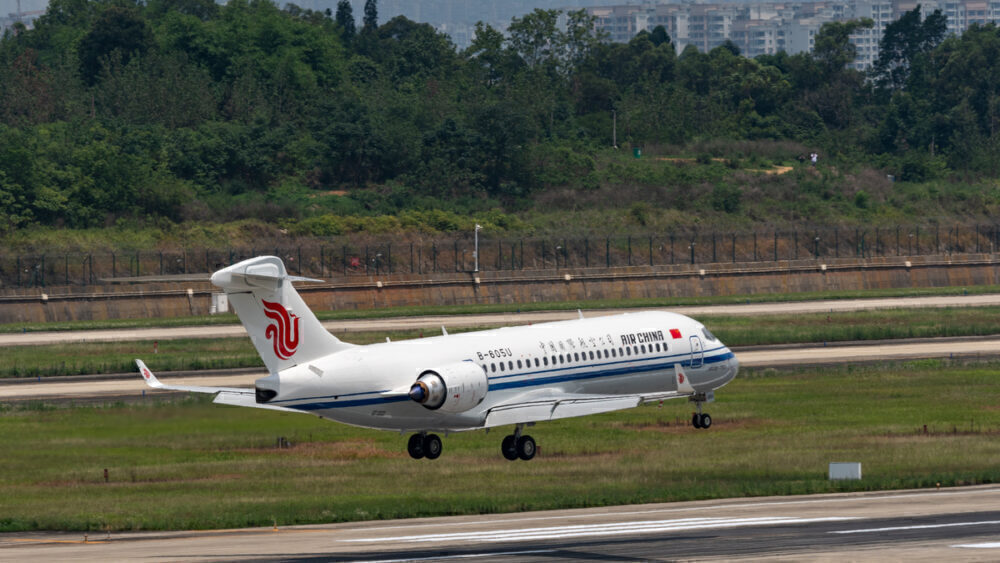Airbus and Boeing have a near-duopoly in the domain of jet-powered commercial aircraft. However, China is looking to become a more significant player in this market, with multiple jetliners set to launch in the next decade. With this in mind, let’s take a look at how these aircraft, and the country’s existing and historic jetliners, compare to similar designs from industry juggernauts Airbus and Boeing.

The Shanghai Y-10
One historical example of a Chinese that bears strong parallels to a Boeing aircraft is the Shanghai Y-10. The Shanghai Aircraft Research Institute developed this four-engine narrowbody jetliner in the 1970s. Of course, by this time, Boeing had already launched a single-aisle quadjet: the 707 family. In fact, the parallels are no accident, with the Shanghai Aircraft Research Institute reportedly having used the 707-320C as a reference point for the Y-10.
In terms of its specifications, the Y-10 was closer to the smaller 707-120. Size-wise, it was around 1.3 meters shorter than the 707-120 (42.93 m vs 44.22 m). Correspondingly, it carried slightly fewer passengers (149 vs 174 one-class, 124 vs 137 two-class).
However, it did match the 707-120 in terms of range. Indeed, both designs could fly for around 5600 km (3,000 NM) with a maximum payload. However, the 707-120 could carry more weight while doing so (123,500 kg maximum takeoff weight vs 102-110,000 kg).

Ultimately, just three Y-10s were produced, with the Civil Aviation Administration of China (CAAC) refusing to take the aircraft on. As a result of this failure, the Shanghai Aircraft Research Institute turned its focus to the McDonnell Douglas MD-82 instead. It was granted permission to assemble the aircraft under license in November 1986.
Stay informed: Sign up for our daily and weekly aviation news digests.
The COMAC ARJ21
In terms of Chinese jetliners that are commercially active today, there is just one example: the COMAC ARJ21 Xiangfeng (‘Soaring Phoenix’). While COMAC (Commercial Aircraft Corporation of China) first revealed the ARJ (Advanced Regional Jet) in December 2007, it did not enter service until June 2016. Today, Planespotters.net reports that 55 have been produced.
Being a small regional jet, the aircraft from the Airbus-Boeing duopoly that the ARJ21 is closest to would have to be the Airbus A220-100. The stretched-fuselage ARJ21-900 is 36.35 meters long, and carries between 98 and 105 passengers.

This gives it a slight degree of overlap with the 35-meter long A220-100, which has a capacity of 100-120 seats. However, in truth, these two aircraft were built to serve rather different functions. While their size and capacity may be similar, the regional-focused ARJ21-900 has a range (ER version) of up to 3,300 km (1,800 NM). Meanwhile, the A220-100 can fly nearly twice as far, clocking in with an impressive range of 6,390 km / 3,450 NM).
Upcoming COMAC designs
In addition to its existing ARJ21 series, COMAC also has two new designs in the pipeline, which are set to enter service in the next decade. Indeed, its narrowbody C919 is tipped to be certified by the end of the year. While this 158-seater can’t match the range of the Airbus A320neo and Boeing 737 MAX 8 (5,555 km / 3,000 NM vs 6,500 km / 3,500 NM and 6,570 km / 3,550 NM respectively), Airbus’s CEO believes it will still provide stiff competition.

COMAC is also teaming up with Russia‘s United Aircraft Corporation (UAC) to challenge Airbus and Boeing in the long-haul domain. The two manufacturers hope to have their CRAIC (China-Russia Commercial Aircraft International Corporation) CR929 in service by 2029.
Simple Flying took a closer look at the aircraft, and how it compares to its European and US competitors, earlier this year. It will be interesting to see how the project pans out, and whether it will ultimately succeed in penetrating the duopoly when service commences.
Have you ever flown on any of these Chinese airliners? Of the ones yet to enter service, which are you most excited about? Let us know your thoughts and experiences in the comments!
from Simple Flying https://ift.tt/3y0qMxr
via IFTTT
Comments
Post a Comment